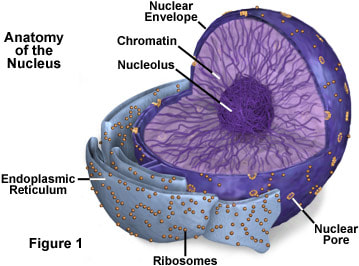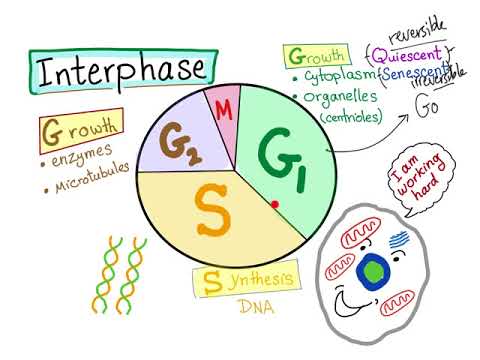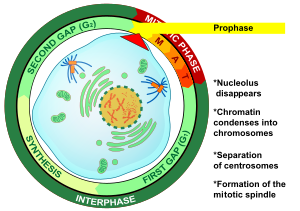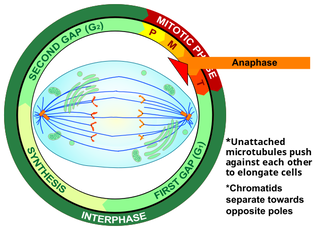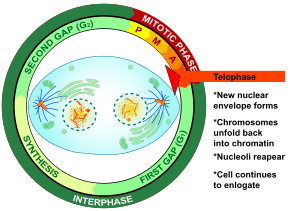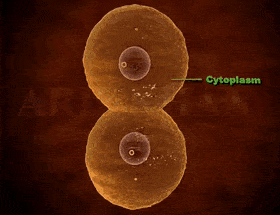Cells & Inheritance
The structure of the nucleus and its functions
The nucleus is a membrane bound structure that contains the cell’s hereditary information and controls the cell’s growth and reproduction.
- It is the command center of a eukaryotic cell and is commonly the most prominent organelle in a cell.
- The nuclear envelope is a double membrane that separates the nucleus from the cytoplasm.
- The nuclear envelope is perforated with numerous pores called nuclear pores.
- All traffic into and out of the nucleus passes through nuclear pores. Inbound traffic includes all nuclear proteins and ribosomal proteins destined for the nucleolus. Outbound traffic includes mRNAs and ribosomal subunits.
- Chromosomes consist of DNA, which contains heredity information and instructions for cell growth, development, and reproduction. When a cell is “resting” i.e. not dividing, the chromosomes are organized into long entangled structures called chromatin and not into individual chromosomes.
- The nucleolus is not surrounded by a membrane, its function is to synthesize ribosomes.
- It is the command center of a eukaryotic cell and is commonly the most prominent organelle in a cell.
- The nuclear envelope is a double membrane that separates the nucleus from the cytoplasm.
- The nuclear envelope is perforated with numerous pores called nuclear pores.
- All traffic into and out of the nucleus passes through nuclear pores. Inbound traffic includes all nuclear proteins and ribosomal proteins destined for the nucleolus. Outbound traffic includes mRNAs and ribosomal subunits.
- Chromosomes consist of DNA, which contains heredity information and instructions for cell growth, development, and reproduction. When a cell is “resting” i.e. not dividing, the chromosomes are organized into long entangled structures called chromatin and not into individual chromosomes.
- The nucleolus is not surrounded by a membrane, its function is to synthesize ribosomes.
Functions of the nucleus
- It controls the heredity characteristics of an organism.
- It is responsible for protein synthesis, cell division, growth and differentiation.
- Stores heredity material in the form of deoxy-ribonucleic acid (DNA) strands. Also stores proteins and ribonucleic acid (RNA) in the nucleolus.
- It is a site for transcription process in which messenger RNA (mRNA) are produced for protein synthesis.
The differences between chromatine and chomosomes.
They are different arrangements of GENETIC MATERIAL found in the cell
They are different arrangements of GENETIC MATERIAL found in the cell
- CHROMATIN : Loose form of genetic material & the “normal state” of DNA and RNA in the nucleus in the cells.
- CHROMOSOME : Condensed form of chromatin, Chromatin becomes chromosomes in the Prophase of Mitosis and Prophase I and Prophase II of Meiosis.
- CHROMATID : Often known as “sister chromatids”, because the two sister chromatids in one chromosome are identical.
The Cell Cycle
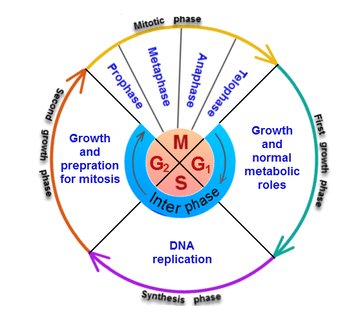
The cell cycle is the period that goes from the moment the cell has just been formed (from the division of the mother cell into two), to the point where the same cell divides in two daughter cells.
The period when the cell is not dividing is called interphase. Therefore, the cell cycle consists of two successive mitotic divisions alternated with a much longer interphase or growth period. Interphase consists of three periods of growth, the first period is called G1, followed by the S phase, during which the chromosomes replicate; and the last part of the interphase is called the G2 phase. This is followed by cellular division (mitosis divides the nucleus and its chromosomes, and cytokinesis divides the cytoplasm, producing two daughter cells).
The period when the cell is not dividing is called interphase. Therefore, the cell cycle consists of two successive mitotic divisions alternated with a much longer interphase or growth period. Interphase consists of three periods of growth, the first period is called G1, followed by the S phase, during which the chromosomes replicate; and the last part of the interphase is called the G2 phase. This is followed by cellular division (mitosis divides the nucleus and its chromosomes, and cytokinesis divides the cytoplasm, producing two daughter cells).
The cell cycle has 2 main stages:
Interphse: where the cell grows, carries out metabolic processes and prepares for cell division
Mitotic phase: Where the cell splits to make 2 new cells
Interphse: where the cell grows, carries out metabolic processes and prepares for cell division
Mitotic phase: Where the cell splits to make 2 new cells
|
INTERPHASE
During the interphase the long filaments of DNA-protein complex called chromatin are spread through the nucleus. The proteins associated with the DNA are called histones. During all three phases of the interphase the chromatin is transcribing itself (therefore synthesizing RNA, mRNA). It is an active period. However, when the cell is getting ready to divide, the chromatin condenses into compactly folded and coiled chromosomes. It is further divided into following phases: G1 phase is also known as First Growth Phase. During this phase, biosynthetic activities occur.. Cell synthesizes more proteins, increase the number of mitochondria and ribosomes. S phase is the phase where DNA is replicated. At the end of DNA replication, each chromosome is with two sister chromatids. G2 phase is the phase where the cell prepare itself for mitosis. PROPHASE
During this phase chromatin condenses to form chromosomes.There are two identical copies of each chromosome which are attached to centromere. During the end of the prophase, nucleolus dissolves. Nuclear membrane also disintegrates at the end. The centrosome moves to the opposite poles. Spindle fibers starts to appear METAPHASE
The second phase of mitosis is metaphase. During this step, the spindles are completely developed and the centrosomes are on opposite sides of the cell. The chromosomes are lined up on the "equator" of the cell, also known as the metaphase plate. Remember how chromosomes are made of sister chromatids? Well, each of these sister chromatids is attached to a spindle from opposite sides of the cell. ANAPHASE
This is the most critical phase of mitosis as it must ensures an equal disrtibution of sister chromatids to each daughter cell. Spindle fibres are attached to the centromere, there are also unattached spindle fibres that work to elongate the cell. The attached spindle fibres then contract towards their pole. This causes the chromosome to break at the centromere and sister chromatids move to opposite poles of the cell. At the end of anaphase each pole will have a complete set of chromosomes. TELOPHASE
In telophase the chromosomes are at the poles and the nuclear membrane reforms to make 2 nucleoli. The chromosomes unwind back to chromatin. The centre of the cell begins to contract and the cell begins to physically separate into 2 new daughter cells. This is known as cytokenisis. |
|
TASK
Draw a labelled diagram of the cell cycle.
Explain what happens during each stage of the cycle.
Watch the video about the cell cycle and cancer
Complete a comic strip to show:
-What happens during the cell cycle in a cancerous cell
TRUE OR FALSE
1.. Mitosis is when the cell divides.
2.. 3 new cells are produced after cell division
3.. During interphase the cell grows and divides
4.. Checkpoints ensure the cell is working as it should.
5.. Cancerous cells go through the cell cycle more slowly than normal cells.
6.. Chemotherapy targets cells which divide rapidly.
7. Cells are in mitosis for about 90% of their lifetime.
8.. Cancerous cells do not go through the checkpoints of the cell cycle.
Draw a labelled diagram of the cell cycle.
Explain what happens during each stage of the cycle.
Watch the video about the cell cycle and cancer
Complete a comic strip to show:
-What happens during the cell cycle in a cancerous cell
TRUE OR FALSE
1.. Mitosis is when the cell divides.
2.. 3 new cells are produced after cell division
3.. During interphase the cell grows and divides
4.. Checkpoints ensure the cell is working as it should.
5.. Cancerous cells go through the cell cycle more slowly than normal cells.
6.. Chemotherapy targets cells which divide rapidly.
7. Cells are in mitosis for about 90% of their lifetime.
8.. Cancerous cells do not go through the checkpoints of the cell cycle.
Meiosis
Animation on punnett squares (click here to see full screen version)
To practise with problems on genetics the following pages could be of help:
LINK 1
LINK 2
LINK 3
Or have a look at these animations to practice with the punnett squares:
LINK 1
LINK 2
LINK 1
LINK 2
LINK 3
Or have a look at these animations to practice with the punnett squares:
LINK 1
LINK 2

